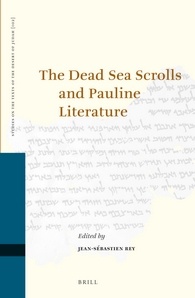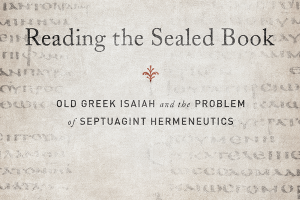This volume, the latest installment of the prestigious and important Studies on the Texts of the Desert of Judah series, is devoted to the question of the interrelationship of Pauline literature and the Dead Sea Scrolls. The collection contains 15 articles (10 in English, 5 in French) from a constellation of internationally recognized experts. In his introduction to the volume Jean-Sébastien Rey articulates three goals for the volume: it is designed to 1) synthesize the scholarly discourse on this topic since 1947; 2) offer prospects for future research; 3) broaden the discussion on this topic to include a robust discussion of the broader social dimensions of Judaism in the first century CE (p. x). The articles in this volume soundly accomplish these no-so-modest goals.
The opening article (“2 Corinthians 6:14-7:1 Again: A Change in Perspective”), by George J. Brooke, revisits this purported interpolation (2 Cor 6:14-7:1) and compares it to works from Qumran. Brooke concludes that “this digression in 2 Corinthians reflects the language and ideas of several Jewish contexts of the late Second Temple period” (p. 13).
Rey’s contribution to the volume (“Les Manuscrits de la Mer Mort et l’Épître aux Galates: Quelques cas d’Interdiscursivité”) notes thematic commonalities between Galatians and material in the Scrolls and attempts to trace these to their shared source (p. 20). Working within the Bahktinian framework of “interdiscursivity” Rey concludes that Paul does not directly use material from the Scrolls, but that both he and the Yahad drew from a broad reservoir of common tradition (p. 48).
In the following article (“Galatians 3:10-14 in the Light of Qumran”) Florentino García Martínez also explores the traditional relationship between the Scrolls and Pauline literature. He discusses particular phrases—“works of the law,” “the curse of the law,” and “the one who is righteous will live by faith”—concluding that “both Paul and the Dead Sea Scrolls develop, each in their own ways…seminal ideas of the Scriptures which are considered authoritative by both corpora of writings” (p. 67).
Lutz Doering (“4QMMT and the Letters of Paul: Selected Aspects of Mutual Illumination”) considers both how MMT illuminates the discussion of the “works of the law” in Pauline thought and how Paul’s letter might elucidate the debate of the genre of MMT (p. 71). In regard to the former, Doering suggests that MMT uses the collocation in reference to “disagreements in halakhic opinion, whereas Paul addresses the question whether Gentile are…obliged to observe halakhah or not” (p. 79). For the latter question, Doering suggests that MMT demonstrates many points of epistolary form (p. 87).
Jan Dušek’s article (“Hesed dans la Règle de la Communauté et charis dans l’épître de Paul aux Galates”) discusses the theological and religious overlap of these parallel Hebrew and Greek terms (that is, hesed and charis) in 1QS and Galatians. Dušek concludes that both of these works use the same terminology but to different theological ends.
The next article (“Philippiens 3,21-4,1 et 1QS IV 6-8”), by Christian Grappe, also explores 1QS (among other documents), but in relation to Phil 3.21-4.1. Like the preceding essays, he concludes that the connections between Pauline literature and Qumran demonstrate their shared fundamental universe (p. 120).
Claude Coulot examines the 1 Thessalonians in light of the Dead Sea Scrolls (“La Première Épître de Paul aux Thessaloniciens à la Lumière des Manuscrits de la Mer Morte”). This essay is a survey of ten instances where the Scrolls can illuminate particular readings or themes in 1 Thessalonians. Coulot concludes that Paul was among and in contact with diverse cultural groups with various doctrines” (p. 140).
Émile Puech (“Les Oeuvres de la Loi: Mariage et Divorce à Qumrân et dans les Lettres de Paul”) explores the application of the phrase “the works of the law,” regarding marriage and divorce. Puech concludes that Paul does not discount the “works of the law” in general, but only the interpretation of marriage law in contemporary Judaism (pp. 168-169).
Menahem Kister (“Body and Sin: Romans and Colossians in Light of Qumranic and Rabbinic Texts”) explores Pauline anthropology in light of similar conceptions at Qumran and in Rabbinic thought. For Kister, Paul and his Jewish contemporaries share “basic assumptions concerning the human condition: the possibility of transforming the human body from its status as the seat of evil into a more purified form” (p. 206).
Friedrich Avemarie (“Image of God and Image of Christ: Developments in Pauline and Ancient Jewish Anthropology”) traces the traditional stream from the biblical creation account in Genesis to Paul’s image-Christology (p. 215). He concludes that “Paul’s imago Christology is a direct offshoot of the reception of Gen 1:26-27 in ancient Judaism. The face of Christ therefore is not only the reflection that shows the believers the flashing glory of God, but unmistakably also bears the traits of Adam and Eve” (p. 235).
Next, Jörg Frey (“Paul’s view of the Spirit in the Light of Qumran”) uses Paul’s pneumatology as a test case for a more constructive method of discussing the parallels between Pauline literature and the Scrolls. He finds that numerous pneumatological perspectives at Qumran illuminate aspects of Paul’s pneumatology: the Spirit as giver of revelation to the community and the Spirit as sanctifying the community, among others (pp. 257-260).
Albert L. A. Hogeterp (“Paul and the Jerusalem Church: Light from the Scrolls on Greco-Semitic Language Contacts and Ethics of Gospel Mission”) undertakes a social-linguistic examination of Paul’s letters with an eye toward clarifying the relationship between Paul and the Jerusalem church. He concludes that part of the disagreement between Paul and Jerusalem church can be attributed to the linguistic milieu of early Christianity.
Jutta Leonhardt-Balzer (“Israel and the Community in Paul [Rom 9-11] and the Rule Texts from Qumran”) asks three related questions of Rom 9-11 and the Rule Documents of Qumran: “What is Israel in each text? Against which background is it used? And how does it function within the argument of the text?” (p. 279). She concludes that “for Qumran Israel’s purpose is to save Israel, for Paul it is to save the world” (p. 293).
Daniel R. Schwartz (“Ends Meet: Qumran and Paul on Circumcision”) analyses the relationship between Paul and Qumran in a sociological vein with a special focus on circumcision. Schwartz’s main argument is that “whether one claims, as in priestly Judaism, that circumcision cannot turn a Gentile into a Jew, or, rather, as for Paul, that circumcision could do that but there is not reason to do it because becoming a Jew is irrelevant to one’s salvation, the result will be the same” (p. 298): despite the ideological differences between Paul and the Yahad, both ultimately reach the same conclusion that circumcision for Gentiles is unnecessary.
The final article of the volume comes from Loren T. Stuckenbruck (“Overlapping Ages at Qumran and “Apocalyptic” in Pauline Theology”). He surveys influential Pauline scholars (Käsemann, Beker, Dunn, and Martyn) and identifies the assumptions that motivate these scholars to describe apocalyptic elements of Paul’s thought in the way that they do. He concludes by examining eschatological segments of Second Temple era texts that reconfigure primordial images.
Overall, the contributions of this volume admirably accomplish the goals set forth in its introduction. Positively, the volume highlights an important element that is often underdeveloped in New Testament scholarship: that the New Testament itself is a witness to particular instantiations of Judaism in the first century CE. Moreover, the contributions move beyond the simple cataloguing of traditional parallels and the contributors are rightfully reticent to suggest that Paul directly reused sectarian documents. Instead emphasis is placed on shared a common reservoir of Jewish tradition. This volume provides a conceptual and methodological framework that represents a welcome advance in research pertaining to the relationship between the Scrolls and the New Testament.
The Botton Line: For the specialist with an interest in the ways that the Scrolls and Pauline literature are mutually illuminating, this volume is required reading. I strongly recommend this volume for such an audience.
Review by Garrick V. Allen (ga22@st-andrews.ac.uk)
University of St Andrews





Leave a Reply
Your email is safe with us.